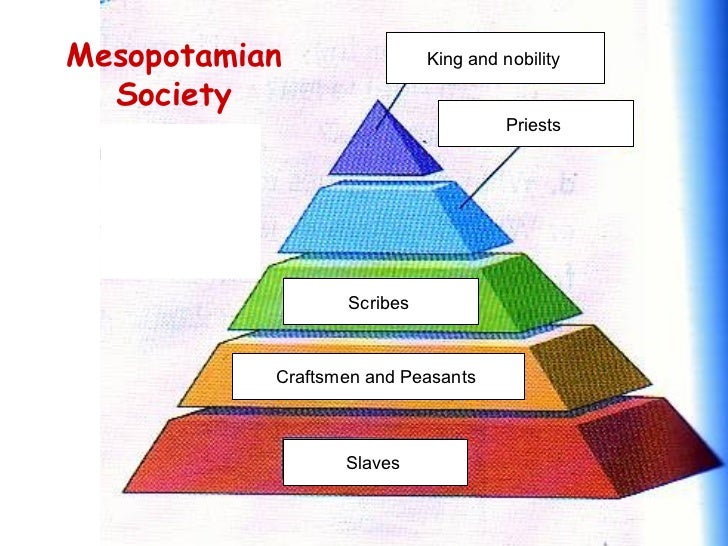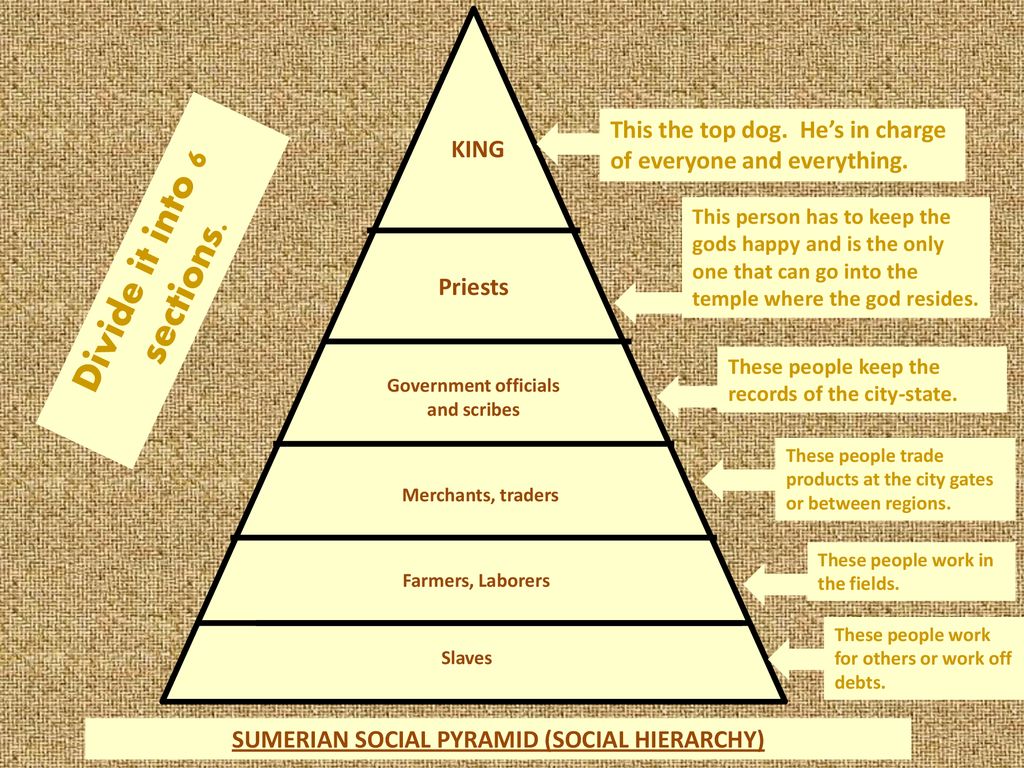Ancient Mesopotamia: Unveiling Social Classes & Pyramid Structure
Did you know that in the cradle of civilization, the ancient land of Mesopotamia, a person's very existence was largely dictated by their social standing? The intricate social structure of Mesopotamia, a complex pyramid of classes, shaped every facet of life, from daily routines and habits to even the outward appearance of its inhabitants.
The social fabric of ancient Mesopotamia, a land nestled between the Tigris and Euphrates rivers, was a tapestry woven with threads of hierarchy and stratification. This complex society, which flourished thousands of years ago, was far from egalitarian. Instead, it was a world sharply divided, a world where the circumstances of one's birth largely determined their fate.
At the apex of this societal pyramid stood the king, often considered a divine ruler, alongside the nobility and powerful priests. Below them were the scribes and merchants, forming an upper class that enjoyed privileges and influence. At the base of the pyramid were the slaves, individuals whose lives were marked by hardship and servitude. The social structure wasn't just about power and wealth; it was about identity, opportunity, and the very essence of one's place in the world. Individuals' positions within this pyramid dictated not only their access to resources but also their daily experiences, their interactions with others, and even their perceived worth.
- Solved Securely Connect Remote Iot Vpc Aws Not Working Fixes
- Ullu Web Series Downloads Your Guide To Streaming Offline Viewing
| Social Class | Roles and Responsibilities | Characteristics | Examples |
|---|---|---|---|
| King | Ruling, lawmaking, religious leadership | Divine status, absolute power, immense wealth | King of Ur, Sargon of Akkad |
| Nobility | Advisors, administrators, military leaders | Wealthy landowners, close to the king, influential | Royal family members, high-ranking officials |
| Priests | Religious rituals, temple management, advising the king | High literacy, access to knowledge, intermediaries with the gods | Temple priests, high priestesses |
| Scribes | Record-keeping, writing, administration | Literate, skilled in writing, crucial for bureaucracy | Royal scribes, temple scribes |
| Merchants | Trade, commerce, distribution of goods | Wealthy, traveled widely, important for the economy | Traders in grain, textiles, metals |
| Artisans | Crafting goods, skilled labor | Skilled in specific crafts, often organized into guilds | Potters, metalworkers, weavers |
| Farmers/Laborers | Agriculture, manual labor | Majority of the population, essential for food production | Farmers, construction workers |
| Slaves | Various tasks, forced labor | Lowest social status, often prisoners of war or debtors | Domestic slaves, field slaves |
Reference: Britannica - Social Class
The social pyramid's structure was not static; it was a dynamic system, constantly shaped by factors like wealth, occupation, and kinship. Furthermore, the channels for upward mobility were limited, although it wasn't impossible. The social classes of ancient Mesopotamia were defined by occupation, wealth, and even familial ties. A farmer's life was drastically different from a merchant's, and a scribe's experience differed greatly from a slave's. These differences were not merely superficial; they defined the very essence of their existence.
One could become enslaved in a variety of ways. Selling oneself into slavery to settle a debt was common, as was being sold by a family member to alleviate debt. Criminals were sometimes punished by being sold into slavery, while others were kidnapped and sold into slavery in another region, highlighting the precarious nature of life for those at the bottom of the social ladder.
The king and his family often stood at the very top, perceived as divine rulers. Alongside the king were the nobility and the priests, who also held significant power and influence. The upper class, composed of scribes and merchants, enjoyed a higher standard of living. Artisans, craftspeople, and metalworkers formed a significant part of the middle class, while the lower class was composed of farmers, laborers, and servants, all essential for the functioning of society. Finally, at the bottom of the social pyramid were the enslaved individuals.
The social hierarchy's rigid structure reflected the values and dynamics of Mesopotamian society. The power of the king was paramount, and religious beliefs played a vital role in social organization. Priests were not merely religious figures; they were also advisors who communicated with the gods, influencing societal decisions. The upper class, composed of government officials and scribes, managed the vast administrative machinery of the Mesopotamian city-states.
The development of this social structure reflected the evolving nature of Mesopotamian society. As cities grew, the need for organized governance increased, as did the roles for merchants and scribes. This structured approach facilitated specialization, enabling individuals to refine their skills and contribute more efficiently to the economy.
This structured approach wasn't unique to Mesopotamia. Similar social pyramids can be observed in many later civilizations. The ancient Egyptians, for instance, also structured their society around a pyramid, with the pharaoh at the top, followed by nobles, priests, scribes, merchants, artisans, and finally, the peasants and slaves.
The social structure was instrumental in shaping the lives of its inhabitants, influencing everything from their daily routines to their interactions with others. Access to resources, opportunities for advancement, and the very definition of one's place in the world were all determined by the social class to which they belonged.
The social order in ancient Mesopotamia was not merely a static arrangement. It was a dynamic framework that shaped economic activity, political power, and cultural expression. The upper classes controlled resources and wielded political influence, while the lower classes provided the labor that supported the society. This structure dictated the very rhythm of life, from the king's opulent ceremonies to the slave's arduous toil. The social hierarchy in ancient Mesopotamia demonstrates the crucial role of social organization in shaping a civilization's trajectory. It reminds us of how societies are structured, and the impact those structures have on the lives of the people who live within them.



Detail Author:
- Name : Christop Gaylord
- Username : heaney.piper
- Email : arlie40@dooley.biz
- Birthdate : 1976-09-28
- Address : 7845 Bosco Fork Hirtheland, WY 31926-3580
- Phone : +1 (254) 348-0943
- Company : Schuppe Group
- Job : Operating Engineer
- Bio : Et consequatur architecto aut minus doloribus dolores. Quis autem adipisci impedit recusandae laudantium voluptas fugit. Eos pariatur cum optio autem rerum ratione voluptatem ipsa.
Socials
twitter:
- url : https://twitter.com/o'connell1985
- username : o'connell1985
- bio : Rerum odit quasi ut dignissimos laborum alias. Nemo mollitia excepturi et autem id. Sed sint accusamus doloribus nihil id a inventore omnis.
- followers : 5260
- following : 2034
tiktok:
- url : https://tiktok.com/@o'connell1996
- username : o'connell1996
- bio : Consequatur aut optio corporis. Magnam ut exercitationem amet.
- followers : 490
- following : 2338